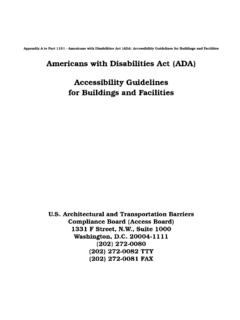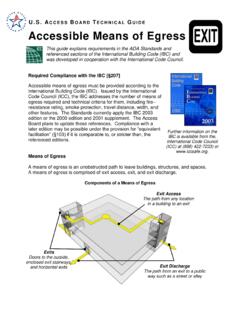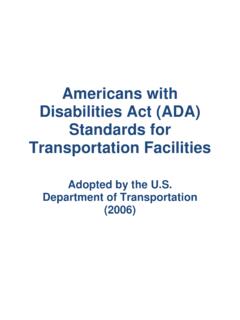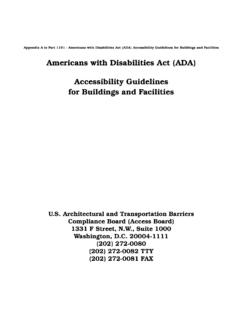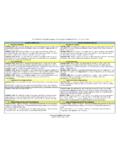Transcription of Americans with Disabilities Act (ADA) Standards
1 Americans with Disabilities Act (ADA) Standards Adopted by the Department of Justice (2010) and the Department of Transportation (2006) About this Edition of the ADA Standards The ADA Standards are issued by the Department of Justice (DOJ) and the Department of Transportation (DOT) and apply to facilities covered by the ADA in new construction and alterations. DOJ's 2010 ADA Standards apply to all facilities covered by the ADA, except public transportation facilities, which are subject to DOT's 2006 ADA Standards . Both Standards are very similar and are closely based on the Board's ADA Accessibility guidelines (ADAAG).
2 However, each contains a few unique provisions, which are noted in this edition of the Standards . Department of Justice ADA Standards (2010) DOJ's ADA Standards (2010) became mandatory on March 15, 2012. They include additional provisions concerning: Assembly Areas (221) Medical Care Facilities (section 223) Places of Lodging (sections 224) Housing at Places of Education (224 and 233) Detention and Correctional Facilities (section 232) Social Service Center Establishments (233) Residential Dwelling Units (section 233) DOJ s Standards are also available on DOJ s website at Department of Transportation ADA Standards for Transportation Facilities (2006) DOT s ADA Standards (2006)
3 Apply to facilities used by state and local governments to provide designated public transportation services, including bus stops and stations, and rail stations. They include unique provisions concerning: Location of Accessible Routes ( ) Detectable Warnings on Curb Ramps ( ) Bus Boarding and Alighting Areas ( ) Rail Station Platforms ( ) DOJ s 2010 ADA Standards for Accessible Design Overview The Department of Justice published revised regulations for Titles II and III of the Americans with Disabilities Act of 1990 "ADA" in the Federal Register on September 15, 2010.
4 These regulations adopted revised, enforceable accessibility Standards called the 2010 ADA Standards for Accessible Design "2010 Standards " or " Standards ". The 2010 Standards set minimum requirements both scoping and technical for newly designed and constructed or altered State and local government facilities, public accommodations, and commercial facilities to be readily accessible to and usable by individuals with Disabilities . Adoption of the 2010 Standards also establishes a revised reference point for Title II entities that choose to make structural changes to existing facilities to meet their program accessibility requirements; and it establishes a similar reference for Title III entities undertaking readily achievable barrier removal.
5 The Department is providing this document with the official 2010 Standards in one publication. The document includes: The 2010 Standards for State and local governments, which consist of the Title II regulations at 28 CFR and the 2004 ADAAG at 36 CFR part 1191, appendices B and D; The 2010 Standards for public accommodations and commercial facilities, which consist of the Title III regulations at 28 CFR part 36, subpart D, and the 2004 ADAAG at 36 CFR part 1191, appendices B and D. The Department has assembled into a separate publication the revised regulation guidance that applies to the Standards .
6 The Department included guidance in its revised ADA regulations published on September 15, 2010. This guidance provides detailed information about the Department s adoption of the 2010 Standards including changes to the Standards , the reasoning behind those changes, and responses to public comments received on these topics. The document, Guidance on the 2010 ADA Standards for Accessible Design, can be downloaded from For More Information For information about the ADA, including the revised 2010 ADA regulations, please visit the Department s website ; or, for answers to specific questions, call the toll-free ADA Information Line at 800-514-0301 (Voice) or 800-514-0383 (TTY).
7 2010 Standards FOR STATE AND LOCAL GOVERNMENT FACILITIES: TITLE II State and local government facilities must follow the requirements of the 2010 Standards , including both the Title II regulations at 28 CFR ; and the 2004 ADAAG at 36 CFR part 1191, appendices B and D. In the few places where requirements between the two differ, the requirements of 28 CFR prevail. Compliance Date for Title II If the start date for construction is on or after March 15, 2012, all newly constructed or altered State and local government facilities must comply with the 2010 Standards . Before that date, the 1991 Standards (without the elevator exemption), the UFAS, or the 2010 Standards may be used for such projects when the start of construction commences on or after September 15, 2010.
8 28 CFR New construction and alterations (a) Design and construction. (1) Each facility or part of a facility constructed by, on behalf of, or for the use of a public entity shall be designed and constructed in such manner that the facility or part of the facility is readily accessible to and usable by individuals with Disabilities , if the construction was commenced after January 26, 1992. (2) Exception for structural impracticability. (i) Full compliance with the requirements of this section is not required where a public entity can demonstrate that it is structurally impracticable to meet the requirements.
9 Full compliance will be considered structurally impracticable only in those rare circumstances when the unique characteristics of terrain prevent the incorporation of accessibility features. (ii) If full compliance with this section would be structurally impracticable, compliance with this section is required to the extent that it is not structurally impracticable. In that case, any portion of the facility that can be made accessible shall be made accessible to the extent that it is not structurally impracticable. (iii) If providing accessibility in conformance with this section to individuals with certain Disabilities ( , those who use wheelchairs) would be structurally impracticable, accessibility shall nonetheless be ensured to persons with other types of Disabilities , ( , those who use crutches or who have sight, hearing, or mental impairments) in accordance with this section.
10 (b) Alterations. (1) Each facility or part of a facility altered by, on behalf of, or for the use of a public entity in a manner that affects or could affect the usability of the facility or part of the facility shall, to the maximum extent feasible, be altered in such manner that the altered portion of the facility is readily accessible to and usable by individuals with Disabilities , if the alteration was commenced after January 26, 1992. (2) The path of travel requirements of (b)(4) shall apply only to alterations undertaken solely for purposes other than to meet the program accessibility requirements of (3) (i) Alterations to historic properties shall comply, to the maximum extent feasible, with the provisions applicable to historic properties in the design Standards specified in (c).
